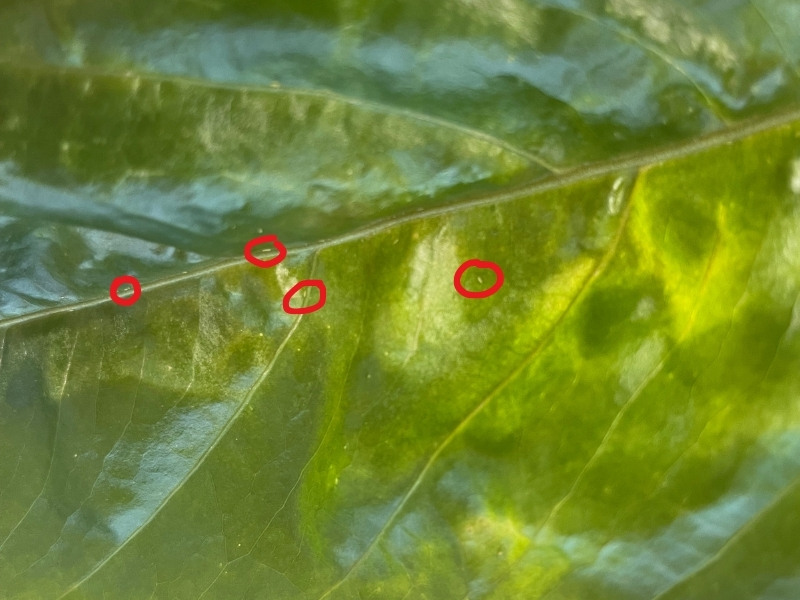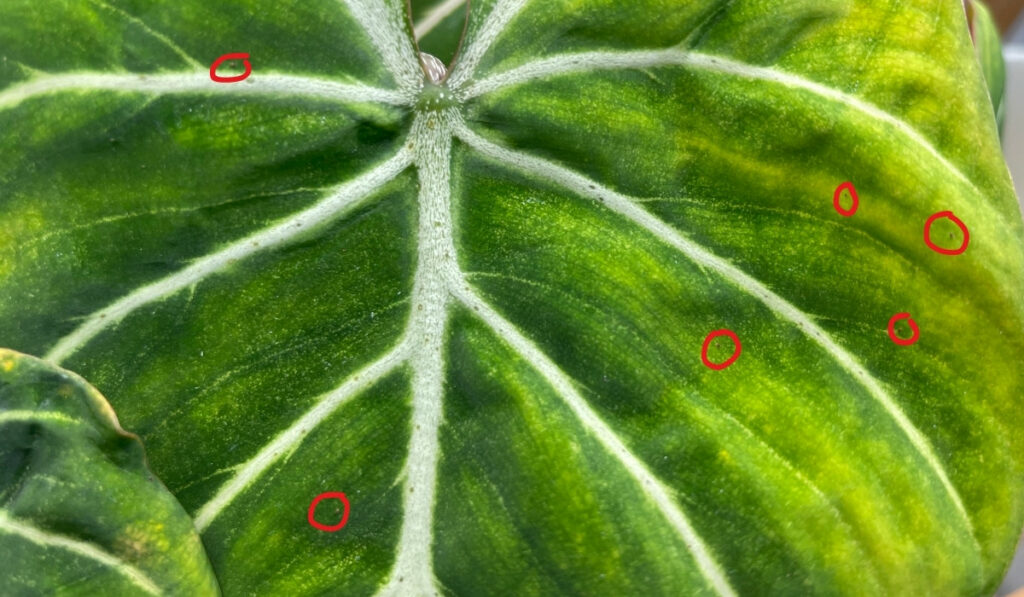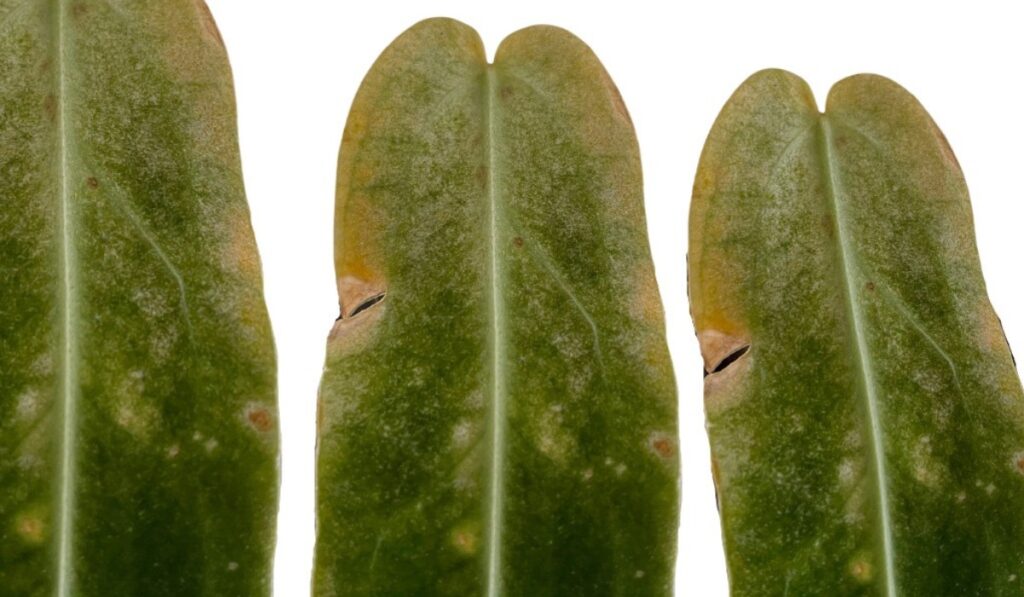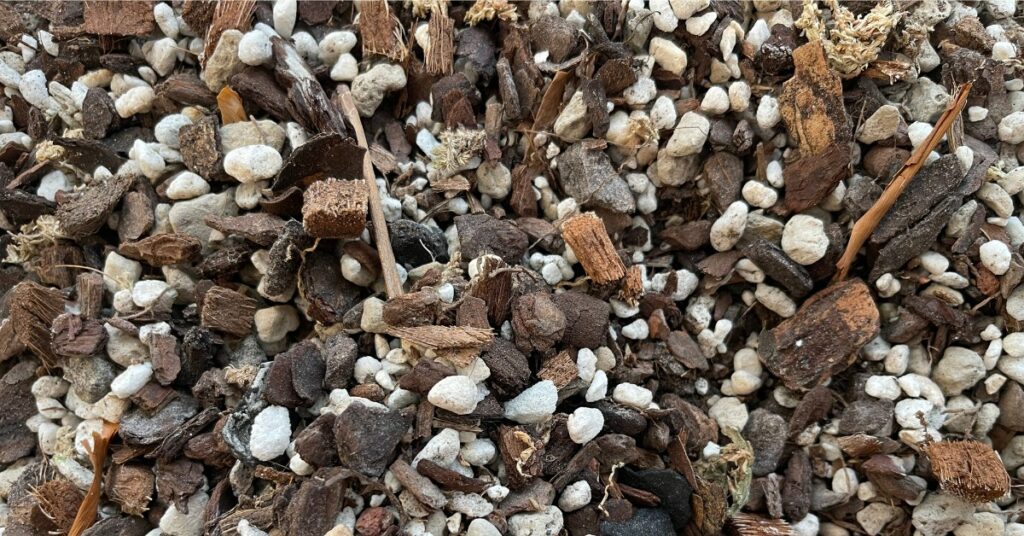Pests, the culprits behind most common problems in anthuriums, wreak havoc on these tropical plants.
The most common anthurium pests include thrips, spider mites, fungus gnats, mealy bugs, aphids, and scale. Stunted growth, yellowing leaves, scarring, and tiny dots on the leaves’ surface can indicate pests.
In this blog, we’ll review the most common anthurium pests, how to spot them, and how to treat the infested plant. Equip yourself with insider tips to keep your plants pest-free!
Most Common Anthurium Pests
In my journey growing various plant genera, I’ve found that anthuriums aren’t particularly susceptible to pests. However, pests have occasionally posed a challenge in my experience with anthurium plant cultivation.
Pests are a normal part of life as a plant grower. Early detection generally renders them a non-issue, allowing the plant to rebound swiftly after treatment. However, severe infestations can occasionally lead to a plant’s demise.
Let’s look at the most common Anthurium plant pests how to ways for pest control.
Thrips
Thrips are tiny, slender insects with fringed wings, often less than 1 mm long. They feed on anthurium plants by puncturing them and sucking up the contents, which causes damage to leaves and the overall deterioration of an anthurium plant. A severe thrips infestation can cause plant demise.

Thrips crawling on my Anthurium bullatus!
Thrips multiply quickly, so check your plants often to catch them early! The developmental time from egg to adult is about 27 days. Female thrips plant eggs in the soft tissue of anthurium leaves, and upon hatching, the larvae feed by sucking the contents of the plant’s cells.
How to spot thrip infestation? You will notice new leaves deformed with white streaks and/or scarring on the leaf surface. You can spot thrips with the naked eye as tiny brownish or black lines. They tend to hide along the leaf veins to avoid being seen.
Thrips are currently eating my Anthurium pedatum and Anthurium bullatus.
Treatment: Use neem oil or insecticidal soap
Spider mites
Spider mites are tiny arachnids, often less than 1 mm in size that can infest anthurium plants, especially those grown indoors. They feast on the undersides of leaves by puncturing the plant cells and consuming their contents.
These tiny insects earn their name from the fine, silk-like webbing they often produce on the plants they infest. When you spot a webbing on the top of the leaves, you already have a severe infestation.
They love dry conditions and thrive indoors where humidity levels are low. If not caught in time, they can decimate the plant.

Spider mites & spider mites damage on gloriosum leaves
How to spot spider mites: If you see fine webbings covering the top of the leaves or over leaf indentation, then you have a spider mites problem. However, sometimes you can’t see the webbing yet but already see the damage they do.
If you see tiny white dots on the leaves, especially around the leaf edges, or sometimes the whole leaf becomes silvery.
In my observation, spider mites are less common on anthurium plants than on philodendrons (looking at your philodendron gloriosum!). But I did spot them before on my Anthurium friedrichsthalii and Anthurium warocqueanum.
Treatment: Predatory mites, neem oil, or insecticidal soap

Spider mites damage on a juvenile Queen Anthurium Warocqueanum
Mealybugs
Mealybugs are tiny, sap-sucking insects notorious for infesting various indoor plants, including anthuriums. They are usually covered with a white, waxy, fluffy material that can be seen with the naked eye, resembling small cottony spots.
Mealybugs feed on the plant sap, leading to wilting, yellowing, and curling of leaves. A severe infestation can weaken the plant significantly and potentially lead to its demise if not controlled.
How to spot mealybugs: It is straightforward to spot them as they look like fluffy white balls. I have yet to have mealybugs on my anthuriums as I typically see them infesting hoyas. Mealybugs absolutely love hoyas.
Treatment: Neem oil. Or Q-tip soaked in alcohol, which kills them instantly. Just dab a Q-tip soaked in rubbing alcohol into each bug. (This is very satisfying!) It won’t harm the plant but will take care of the mealybugs by dehydrating their protective covers.
Aphids
Aphids are small, soft-bodied insects that feed on plant sap, often causing damage and transmitting diseases. They can be found in various colors but are often known as blackflies, greenflies, or whiteflies.
How to spot aphids: To spot aphids on leaves, inspect the undersides since they favor this protected area. They also like new growth tips of plants.
Aphids often cluster together in colonies, so look for these groupings. Additionally, signs of their presence can include curled, yellowed, or distorted leaves indicative of aphid damage.
Also, look for a sticky substance called honeydew, a byproduct of their feeding, which can attract ants.
I’ve yet to see aphids on my anthuriums.
Treatment: Neem oil, ladybugs
Fungus gnats
Fungus gnats are small, dark, short-lived insects that pose a common issue for indoor anthuriums. These pests are particularly attracted to damp, rich soil, often found in indoor plant settings.
The adults are primarily a nuisance, flying around the plants and home. However, it’s the larvae that cause real concern. They feed on plant roots and organic material in the soil, which can stunt the growth of anthuriums and cause yellowing and wilting of the plant.

Overwatering or a lack of proper drainage can create an ideal breeding ground for fungus gnats, underscoring the importance of well-drained soil and careful watering for indoor anthurium plants.
How to spot fungus gnats: The adult flies fly around the plant that has wet soil. When you shake the pot, it will start escaping from the soil.
Treatment: Luckily, getting rid of fungus gnats is very easy. Hold off on watering slightly longer to get the top part of the soil to dry out. Larvae only go a couple of cm deep into the soil. They also love yellow, so some growers use yellow sticky notes on top of the soil to attract them, but I wouldn’t bother. Getting the soil dry will eradicate this pesky pest fast.
You can also use a peroxide and water solution and soak the soil. This will kill the larvae and eggs.
Some anthurium enthusiasts also use diatomaceous earth, a fine white powder made from the fossilized remains of tiny aquatic organisms called diatoms. It’s often used as a natural pesticide because its microscopic, razor-sharp edges can cut through the protective coverings of insects and ultimately cause them to dehydrate and die.
It’s non-toxic for plants, humans, and pets.
Scale
Scale insects are a group of pests that can pose a significant threat to indoor anthurium plants. These small, round, or oval-shaped bugs attach themselves to the stems and leaves of the plant, camouflaging themselves to blend with the plant’s coloration. They come in various colors – brown, black, or white, often resembling tiny bumps or shields on the plant surface.
Scale insects feed on the plant’s sap, draining nutrients and vitality. This feeding behavior can lead to yellowing or wilting leaves, stunted growth, and in severe cases, the plant’s demise.
They also excrete a sticky substance known as honeydew, which can promote the growth of sooty mold and attract other pests. Early detection and intervention are crucial in managing scale infestations indoors, as they can quickly spread to other houseplants if left unchecked.
How to spot scale: Scale tends to form tiny bumps along the veins of Anthurium leaves or on stems. If your plant growth is slowed down, check for scale!
Treatment: White oil spray, neem oil. Also, a Q-tip with alcohol can work.
Outdoor Anthurium Pests
If you’re lucky enough to live in the tropical zone where you can grow anthurium outdoors, you’ll encounter a different set of pests. Snails, caterpillars, and sometimes rats and iguanas are among the most common pests outdoors.
I grow all my anthuriums indoors and don’t have experience dealing with outdoor pest control.
How to prevent and control anthurium pests
Prevention is critical when it comes to pest management and control. Preventing pests on anthuriums involves a few key steps:
- Regular Inspection: Regularly check your anthurium plants for signs of pests. Look for changes in leaf color, spots, or curling, and check the underside of leaves for any small insects or eggs. Also, if the plant stops growing, it can indicate pests lurking. All pests love the new growth. Check the newest leaves first because insect pests love fresh, new growth. Often, I’ve discovered pests solely on these young leaves, leaving the mature ones untouched while ravaging the new growth.
- Proper Watering: Overwatering can attract pests like fungus gnats. Water your anthuriums thoroughly and keep the soil moist but never soggy. Overwatering won’t be an issue if you’re using a chunky, well-draining potting mix. Check my in-depth guide on Anthurium watering.
- Proper Air Circulation: Good air circulation can discourage pests. If you’re growing anthuriums indoors, consider using a small fan to improve air movement.
- Avoiding Contamination: Be cautious when introducing new plants to your existing collection. New plants can carry pests. Isolate new plants for a few days or weeks and check for any signs of pests before placing them near your other plants.
- Regular Cleaning: Clean the leaves regularly. Wipe them with a soft damp cloth or shower them. This will wipe out any lurking pests. You’ll probably avoid heavy infestations if you’re checking your plants regularly. I always take time during watering to check for pests. This strategy always pays off as I’m able to spot them early.
- Healthy Plants: Keeping plants healthy is the best way to prevent pests. Healthy plants are less susceptible to pest infestations. Ensure your anthuriums grow in the right potting mix, get the right amount of light, water, nutrients, and repot when necessary. Read my in-depth guide to Anthurium repotting.
- Use of Natural Pesticides: If you notice the presence of pests, consider using natural pesticides or insecticidal soap. These can help control the pest population and prevent further infestation. Sometimes natural ways of pest control don’t work.
Using a chemical systemic pesticide can work very well, but the damage to the natural environment these pose is not something I’m willing to do to keep my plants pest free.
Also, why would you want to introduce such toxins to your home environment? But if you decide to use them, always follow the instructions on the pesticide label, as these are very toxic to humans and pests.
Remember, early detection is the key to preventing severe pest infestations.

